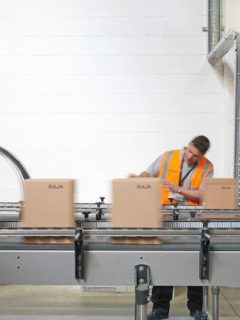In 2019, our survey revealed that the #3 priority for e-retailers for the year was to find eco-responsible packaging. This initiative is in line with the expectations of the modern consumer, who wants to have a minimal impact on the planet. However, responsible logistics cannot be envisaged without thinking about last-mile logistics, whose environmental impact remains massive.How can you change your e-retail practices to make your deliveries more environmentally friendly? Discover here 7 tips to reduce the ecological impact of your last-mile logistics
- Reduce the empty space in your packaging
- Choose eco-responsible last-mile transporters
- Go all-green on short distances
- Optimise delivery rounds
- Questioning your delivery times
- Implement an order consolidation strategy
- Offset your carbon emissions
reduce the empty space in your packaging
The first step you should take, even before you take an interest in the transport of your parcels, is to reduce the empty space in your packaging as much as possible. When you reduce the empty space in your packaging, you reduce the space taken up by your carriers’ containers, and thus save unnecessary CO2 emissions. To do this, you will need to optimise the volumetric weight of your parcels. ColisConsult and RAJA have joined forces to create a simple and practical method for reducing the empty space in your packaging. In just a few steps, you can
- Analyse the dimensions of your packaging, and observe which references are most frequently sent
- Break down your shipments by weight range, by referring to your carriers’ price lists
- Analyse your results to adapt your packaging range
the result: less empty space in your boxes, lower carbon emissions, and reduced costs on your express and international shipments.
Choosing eco-responsible last mile carriers
To control the environmental impact of your last mile logistics, make sure you monitor the practices of your carriers. In an era of increasingly eco-responsible transport, they should be able to provide you with information on their carbon emissions. Some of these responsible carriers offer
- Green fleets”, using electric, LPG or CNG trucks
- Compliance with the Label CO2 charter, approved by ADEME
there is no shortage of good practice in reducing CO2 emissions from transport: ask the service providers you partner with for proof. cta id=’8f6ba012-a28d-4082-bd61-5a8f10436985′]
Going all-green on short distances
The ecological impact of last-mile logistics is particularly significant in urban areas. However, you can go further than just ‘green fleets’ on shorter distances. Some carriers offer totally impact-neutral delivery solutions such as:
- Bicycle couriers, for small deliveries
- Cargo-cycles, for larger parcels
in order to adopt a totally responsible approach, you should also make sure that your transporters do not subcontract these totally green deliveries; the aim being to promote sustainable and stable employment for all those involved in transport.
Optimising delivery rounds
A parcel that cannot be delivered at the first instance is a parcel that pollutes more. Therefore, make sure that you use as much as possible new technologies to optimise delivery rounds over the last kilometre
- Geolocalise the parcel in real time, to ensure that the recipient and the carrier meet as closely as possible, and thus limit the number of instances
- Give the end customer control over the delivery of his parcel, for example by offering him, a few hours before the round, to choose a drop-off point or a specific delivery time
in addition to limiting your carriers’ travel, you add an extra layer of customer satisfaction to the service. Your customer is then delighted to receive their parcel in person, or at the time and place they want. Questioning
Questioning
your delivery times
By definition, a faster delivery is a more polluting delivery. In express, you generally send emptier containers, which could be optimised if the carrier could wait longer to fill them. Therefore, think about making your customers more responsible, by giving them the opportunity to have their parcel delivered later, in a more eco-responsible way. As an e-commerce decision-maker, it is your responsibility to commit to, and communicate for, practices that are less impacting on the environment. However, be sure to communicate well about the “green” nature of this choice
- Join forces with partner companies, or companies that are close to you in geographical terms, in order to create synergies between your deliveries.
- Use specific order consolidationservices, such as Bring4You or the professional service of Cocolis.
compenser ses émissions carbone
Parce qu’il est compliqué de totalement faire disparaître l’impact environnemental de sa logistique du dernier kilomètre, pensez à compenser les émissions carbone que vous n’avez pas réussi à éradiquer.
Certains organismes, tels qu’Entrepreneurs du Monde ou GoodPlanet, proposent des programmes de compensation carbone intéressants. Le principe : vous cumulez les “crédits carbone”, liés à votre taux d’émissions de CO2, que vous pouvez ensuite reverser dans des projets à caractère responsable.
C’est par exemple le parti pris de l’entreprise FAGUO : à chaque commande expédiée, ce e-commerçant plante un arbre en France. Comme nous l’avait dit Frédéric Mugnier, co-créateur de la marque, dans une interview inspirante:
Très vite, nous nous sommes rendu compte que les émissions de CO2 étaient inévitables : par conséquent, nous avons mis en place une action de compensation par la reforestation. En somme, s’il est impossible de totaleme














